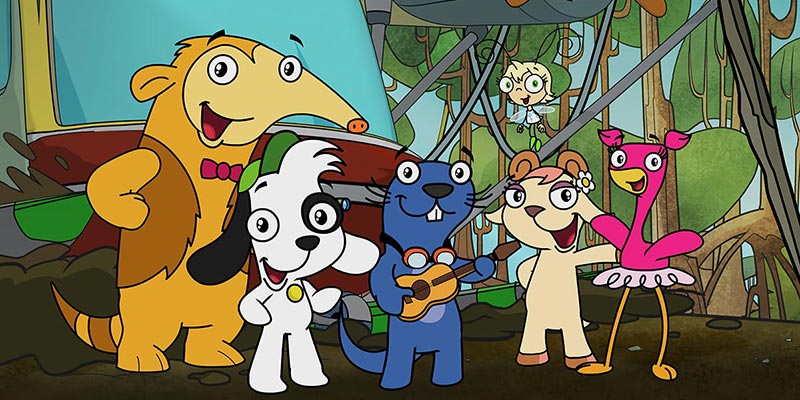Portfolio Entertainment co-founder and Executive Producer, Lisa Olfman, speaks with Gina Power (2017 WIFT-T Showcase Selection Committee) and WIFT-T staff on the creation of Freaktown, why Canada is known internationally for children’s animation, her theory on why this is the Golden Age of Television, and the secret to her long-time partnership with her friend and colleague, Joy Rosen.
How did Portfolio Entertainment get involved in Freaktown?
Portfolio has been very fortunate to have a longstanding and successful relationship with TELETOON which had a development agreement in place with the Freaktown creators Philippe Ivanusic-Vallee and Peter Ricq (League of Super Evil)
When TELETOON presented us the opportunity to produce the show in collaboration with Peter and Philippe, we jumped at the chance. Our history with Corus Kids includes multiple seasons of Groundling Marsh followed by multiple seasons of the animated series Carl2 and Roboroach for TELETOON and The Cat in The Hat Knows a Lot About That for Treehouse. With our track record in creative storytelling and execution in animation, we were a natural fit for this project.
The result was a zany comedy with a unique charm that is packed with imaginative action, visual comedy and hilarious storylines, and Freaktown has now sold around the world. Fun fact: Freaktown was Portfolio’s inaugural series to pass through our freshly minted animation studio where we handle all pre-production, design, storyboards and edit.
Canada is well-known for our animated children’s content. Why do you think we as a country excel at this genre?
First and foremost, Canada is flush with world class talent from coast to coast and institutions like Sheridan College produce a steady flow of great animators and content creators every year. Canada is also consistently on the leading edge of technology. We are pioneers in developing innovative hardware and software solutions to drive a more efficient animation pipeline. At the end of the day, it is our ability to combine creative excellence and efficient execution which makes Canada stand out as a leader in the animation industry.
The advent of specialty television in the late 90s gave the animation industry a new distribution outlet and increased demand for programming as broadcast revenues soared. Broadcast partners like TELETOON became incredibly successful and began commissioning significant amounts of animated content that in turn sold around the world. This coupled with favourable funding and tax incentives encouraged the production of homegrown content and enabled Canadian producers to keep talent from heading to LA. This growth period provided invaluable experience as the animation industry took off.
The key to continued success for the animation industry in Canada is to ensure that the regulator is persuaded (and all evidence points in this direction) that supporting Canadian-produced kids’ animation shows is good for economic growth, international recognition as well as cultural sovereignty for the next generation of Canadians.
You’ve been in the industry for many years. How has it changed, especially in regards to opening doors for women?
Actually, the more the industry changes, the more it stays the same. My partner and I have seen major technological disruption in the media space: the advent of specialty channels, the collapse of the home video market, the explosion of mobile and streaming. Each time, the naysayers herald the collapse of the content industry and yet, we are still here after 25 years, producing and distributing great shows in what is being called the Golden Age of Television. As female entrepreneurs, we have faced challenges from doubting financiers to skeptical international partners. With time, perseverance and proof of performance, we have built one of Canada’s leading content companies.
What has changed most recently is awareness and action with regards to gross gender imbalance across all decision-making categories in our industry. We welcome the initiatives of the CMF, Telefilm, the CBC and other broadcasters to address the issue of inequality, not only for women directors but also for writers, editors, creative directors, and producers. It’s long overdue and Portfolio is committed to providing job opportunities for talented women creatives in live action and animation.
You and Joy Rosen started Portfolio Entertainment in 1991, and have worked together on countless projects since. What keeps your partnership successful?
 The key to any successful partnership is having a shared vision and an aligned set of values. Our business thrives in a corporate culture that is committed to integrity, creative excellence, innovation, and collaboration. Joy and I both set very high standards for ourselves and our team and share a common unwavering drive for success. We’re always moving forward and adapting to change. It keeps us invigorated and we run the company with the energy of today’s best startups. We are not afraid of risk nor of turbulent times – we are both survivors!
The key to any successful partnership is having a shared vision and an aligned set of values. Our business thrives in a corporate culture that is committed to integrity, creative excellence, innovation, and collaboration. Joy and I both set very high standards for ourselves and our team and share a common unwavering drive for success. We’re always moving forward and adapting to change. It keeps us invigorated and we run the company with the energy of today’s best startups. We are not afraid of risk nor of turbulent times – we are both survivors!
Success is also attributable to our ability to communicate and freely exchange ideas. After 25 years together, there isn’t anything we can’t say to each other. Honesty and open dialogue have been paramount to our success.
Most importantly, we genuinely love coming into work every day. We’re surrounded by a team of wonderfully creative, talented and passionate people who are all experts at what they do best and that keeps us motivated.
What advice do you have for up-and-coming content creators?
While great storytelling is always the key to success, content creators today have to think globally and they have to think about their role in building audience. The changing media landscape internationally has made it necessary to think beyond the traditional local linear broadcast model. As consumption habits continue to evolve, there is more of a direct link to the consumer and understanding your audience is essential.
It’s also important for content creators to be active partners, not only in producing the end-product but in building a brand, engaging the audience and enhancing reach. Discoverability is not just the responsibility of the broadcast or distribution partner. Producers and creators need to get involved in promoting the product to ensure success.
What’s next for you?
The traditional television industry is undergoing massive disruption from the internet and consumption of content has changed dramatically. At the same time, the demand for premium, high-quality content from experienced producers like Portfolio has never been greater. This has led us to expand our capacity. First, through the launch of our best-in-class animation studio and second, through our content diversification strategy. Portfolio is now developing ‘tween and family live action comedies as well as exploring digital-first content. We have a long-standing relationship with PBS and are currently in production on an entirely new property called Super Hero School. We’re also working on new seasons of our animated series Doki and Cat in The Hat Knows a lot About and have several new properties in development with broadcasters. But, we are continually looking for partners with brilliant new ideas!
Finally, at a time of industry consolidation, we believe that there are still opportunities for the bespoke services of a boutique distributor like Portfolio. We continue to acquire third party shows, like our recent announcement of Small Town, Big Mayor, and our distribution team brings a forward thinking, “no-stone-unturned” philosophy to each title they distribute.

